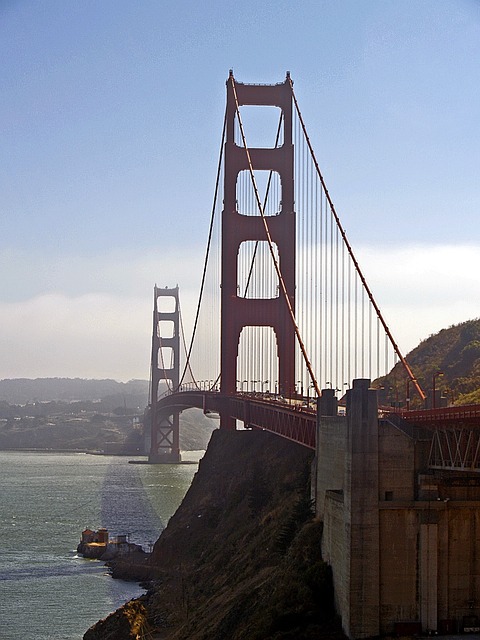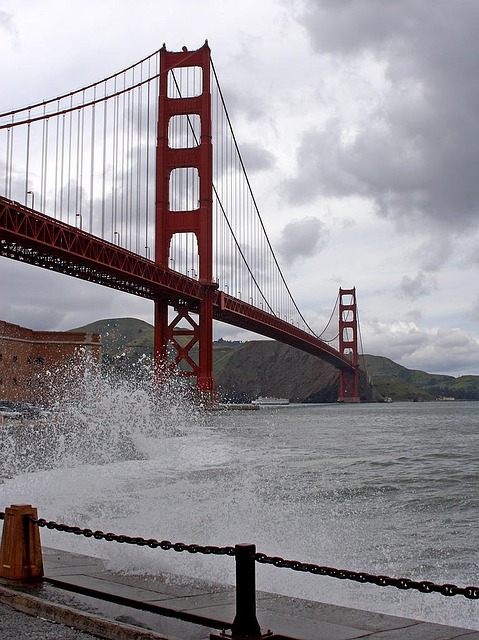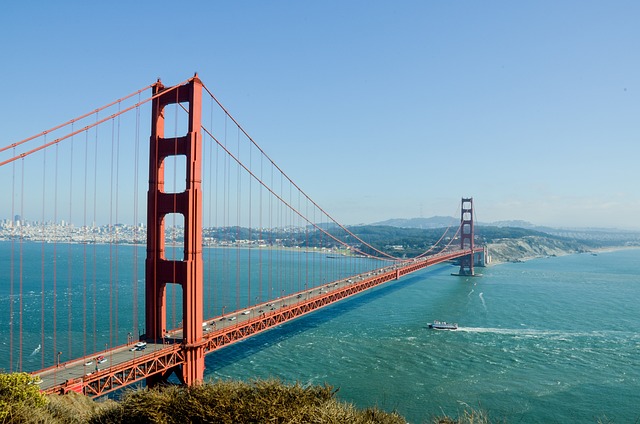The Golden Gate Bridge is a world-renowned iconic landmark of San Francisco. This impressive bridge has a rich history and has become a symbol of the city and the United States.
In this article, we will delve into the design, construction, and current status of the Golden Gate Bridge. We will explore its unique features, the challenges faced during its construction, and its significance in popular culture.
From its economic impact to its role in connecting the city, the Golden Gate Bridge is truly a marvel of engineering and a beloved cultural icon. Let’s take a closer look at this magnificent bridge and discover all that it has to offer.
Table of Contents
The Design of the Golden Gate Bridge
The Golden Gate Bridge is a masterpiece of engineering and design, and has become an iconic landmark of San Francisco. Its distinctive orange color and elegant suspension structure make it one of the most recognizable bridges in the world. In this section, we will take a closer look at the design of the Golden Gate Bridge, from its inception and construction to its current status as an engineering marvel.

The Design Competition and Joseph Strauss:
The idea for the Golden Gate Bridge was first proposed in the late 19th century, but it wasn’t until the early 20th century that a design competition was launched to select the best design for the bridge. After receiving numerous submissions from architects and engineers, the winning design was chosen in 1933 by Joseph Strauss, an experienced engineer with a background in bridge building.
Unique Features:
The Golden Gate Bridge is a suspension bridge, which means it is held up by cables that are anchored to towers at either end. Its main span is 4,200 feet long, making it one of the longest suspension bridges in the world. What makes the bridge truly unique is its signature orange color, which was originally used as a primer to protect the steel from corrosion. However, the color was so well-received by the public that it was kept as the final color for the bridge.
Engineering Challenges:
Building the Golden Gate Bridge was no easy feat. The bridge had to be designed to withstand strong winds, powerful tides, and even earthquakes. To address these challenges, Strauss and his team of engineers came up with innovative solutions, such as using a flexible suspension system and incorporating a deep anchorage system to withstand the powerful currents in the Golden Gate Strait.
Construction Process:
The construction of the Golden Gate Bridge began in 1933 and was completed in 1937. It was a massive undertaking that involved the work of thousands of workers, many of whom were unemployed during the Great Depression. The construction process required the use of innovative techniques and materials, such as the use of a temporary safety net to prevent workers from falling into the water, which saved the lives of 19 workers.
Economic and Transportation Impact:
Aside from its engineering achievements, the Golden Gate Bridge also had a significant impact on the city’s economy and transportation system. It provided much-needed employment during the Great Depression and has become a major tourist attraction, bringing in millions of visitors each year. The bridge also helped to alleviate traffic congestion in the city, providing a vital link between San Francisco and the surrounding areas.
In conclusion, the design of the Golden Gate Bridge is a testament to the ingenuity and perseverance of its designers and builders. Its unique features and engineering challenges make it a symbol of human achievement and a beloved landmark of San Francisco. As we continue to admire its beauty and functionality, let us not forget the incredible effort and innovation that went into creating this iconic bridge.
Construction of the Bridge
The construction of the Golden Gate Bridge was a monumental feat, both in terms of engineering and economic impact. The project began in 1933 and was completed in 1937, during the height of the Great Depression. It provided much-needed employment for thousands of workers and transformed the city of San Francisco forever.
The construction process of the Golden Gate Bridge was a massive undertaking that required innovative techniques and materials. The design by Joseph Strauss was chosen from a design competition, and it incorporated unique features such as its suspension structure and signature orange color. The bridge is 8,981 feet long, 746 feet high, and features two main towers that are 500 feet tall.
The initial step in the construction process was to build the two main towers. This was done using a technique called cantilever construction, where two halves of the tower were built simultaneously and then joined together at the top. This was a challenging engineering feat, but it allowed for the towers to be built higher and stronger.
Once the towers were completed, the next step was to construct the main span of the bridge, which was done using a method called the “catwalk system.” This involved workers hanging from ropes and walking along the main cables to install the bridge’s main segments. This method was not only efficient but also reduced the risk of accidents.
The Golden Gate Bridge also played a significant role in providing employment during the Great Depression. The project created jobs for thousands of workers, including engineers, ironworkers, and laborers. The construction of the bridge also brought in a lot of money to the city and helped boost the economy.

The completion of the Golden Gate Bridge had a profound impact on the city’s transportation system. Before the bridge, people had to rely on ferries to travel between San Francisco and Marin County. The bridge not only provided a more efficient mode of transportation but also connected the city to other popular destinations, such as the California coast and the Golden Gate National Recreation Area.
Today, the Golden Gate Bridge remains an important landmark and a vital part of San Francisco’s infrastructure. It sees an average of 112,000 vehicles crossing the bridge every day, and its iconic red-orange color is recognized worldwide. The bridge is also a popular tourist attraction, with over 10 million visitors every year.
To keep the bridge in top condition, regular maintenance and preservation efforts are carried out. This includes repainting the bridge every seven years to protect it from the salty ocean air and regular inspections to ensure its structural integrity. In recent years, the bridge has also undergone significant renovations and upgrades to improve its safety and sustainability.
The Golden Gate Bridge’s construction was not just a technical feat, but it also had a significant cultural impact. It has been featured in numerous films, books, and artwork, solidifying its place as a symbol of the city and the United States. The bridge is also a popular spot for events and celebrations, such as the annual Bridge to Bridge Run and the 50th-anniversary celebration in 1987.
Despite its massive size and impact, the Golden Gate Bridge was designed with the environment in mind. It seamlessly integrates with the natural landscape and provides stunning views of the San Francisco Bay. Additionally, measures have been taken to minimize its carbon footprint, such as converting the bridge’s lights to LED and implementing a program to collect and recycle rainwater.
The Golden Gate Bridge is not just a bridge; it is a testament to human ingenuity and a significant part of San Francisco’s history. Its construction served as a beacon of hope during a time of great economic hardship and continues to be a source of pride for the city and the United States.
The Golden Gate Bridge Today
As one of the most recognizable and beloved landmarks in San Francisco, the Golden Gate Bridge stands tall and proud, linking the city to Marin County and the rest of Northern California. Since its completion in 1937, the bridge has become a symbol of the city, attracting millions of visitors each year to marvel at its iconic design and breathtaking views.
Statistics on the bridge:
– The Golden Gate Bridge is approximately 1.7 miles long, making it the longest suspension bridge in the world at the time of its construction.
– The bridge stands at 746 feet tall, towering over the San Francisco Bay and providing stunning views of the city skyline.
– On average, over 40 million vehicles cross the bridge each year, making it one of the most heavily trafficked bridges in the world.
Maintenance and preservation efforts:
Maintaining such a massive and iconic structure is no easy feat, but the Golden Gate Bridge has been well taken care of throughout its 80+ years of existence. Regular inspections and maintenance are carried out to ensure the bridge remains safe and in top condition for both commuters and tourists.
In recent years, the bridge has undergone several renovation and upgrade projects to improve its functionality and safety. In 2012, the bridge’s toll plaza was converted to an all-electronic system, eliminating the need for toll collectors and reducing traffic congestion. The bridge’s famous orange color is also regularly repainted to maintain its vibrant appearance.
Cultural significance:
The Golden Gate Bridge has not only become an iconic symbol of San Francisco, but it has also cemented itself in popular culture. It has been featured in countless films, books, and artwork, showcasing its enduring appeal and impact on the city’s identity.
Furthermore, the bridge has played a significant role in various events and celebrations over the years. The annual Bridge to Bridge Run attracts thousands of runners from around the world, and the bridge’s 50th anniversary in 1987 was marked with a grand celebration attended by thousands of people.
Environmental impact:
One of the most impressive aspects of the Golden Gate Bridge is how it seamlessly blends with its natural surroundings. The bridge is an integral part of the San Francisco Bay Area’s landscape, and its construction took into consideration the surrounding environment.
In recent years, the bridge has also taken steps to minimize its carbon footprint and protect the environment. Solar panels have been installed to power the bridge’s light fixtures, and efforts have been made to reduce the amount of waste produced during maintenance and construction projects.
The Golden Gate Bridge is not only a feat of engineering but also a testament to the city’s resilience and ingenuity. It has stood the test of time and continues to be a symbol of hope, progress, and unity for the people of San Francisco. Whether it’s your first time seeing it or your hundredth, the Golden Gate Bridge never fails to inspire and captivate.

Cultural Significance
The Golden Gate Bridge has not only become an iconic landmark of San Francisco but also a global symbol of engineering and architectural excellence. In this section, we will explore the bridge’s cultural significance and its impact on popular culture and the city’s identity.
Since its completion in 1937, the Golden Gate Bridge has been featured in numerous films, books, and artworks, solidifying its status as one of the most recognizable bridges in the world. From Alfred Hitchcock’s thriller “Vertigo” to the popular video game “Grand Theft Auto,” the bridge has been a prominent setting for many creative expressions. The bridge has also been featured in literature, including the popular novel “Golden Gate” by Vikram Seth, which tells the story of five friends living in San Francisco and their connections to the bridge. The bridge’s imposing structure and mesmerizing orange color have made it a favorite subject for artists, photographers, and tourists alike.
The Golden Gate Bridge is more than just a physical structure; it holds significant symbolism for the city of San Francisco and the United States. As a symbol of progress and modernity, the bridge has come to represent the city’s innovation and resilience. Additionally, it has been labeled as a “wonder of the modern world” and is recognized as a National Historic Landmark by the National Park Service. The bridge has also been featured on postage stamps, coins, and even on the state quarter of California.
The bridge has played a crucial role in the city’s social and cultural events, bringing people together and creating a sense of community. Every year, thousands of runners participate in the Bridge to Bridge Run, a popular event that celebrates the bridge’s history and challenges runners to complete a course spanning from the Golden Gate Bridge to the Bay Bridge. The bridge has also been a popular spot for marriage proposals, wedding ceremonies, and other special occasions, making it an integral part of people’s personal lives.
In 1987, the Golden Gate Bridge celebrated its 50th anniversary with a grand celebration that attracted millions of visitors from around the world. The event included a parade, fireworks, and speeches from distinguished guests, including former President Ronald Reagan. The bridge continues to be a site for major events, such as the annual Fleet Week, where the U.S. Navy’s Blue Angels perform their famous air show above the bridge, drawing large crowds and generating significant tourism revenue for the city.
Apart from its cultural significance, the Golden Gate Bridge has also had a significant impact on the environment and the city’s landscape. The bridge’s construction required the removal of over 1.2 million cubic yards of dirt and rock, which were later used to fill the nearby areas, creating new land for development. The bridge’s integration with the natural landscape is a testament to the bridge’s designers’ and engineers’ vision, who ensured that the bridge would not disrupt the surrounding environment. The bridge also serves as a habitat for seabirds and marine life, and efforts are continuously made to protect and preserve the bridge’s surrounding ecosystem.
In conclusion, the Golden Gate Bridge is more than just a bridge; it is a cultural and historical icon that has shaped the city of San Francisco’s identity. With its unique design, rich history, and significant impact on popular culture, the Golden Gate Bridge will continue to be a symbol of pride and progress for generations to come.
The Golden Gate Bridge and the Environment
The Golden Gate Bridge is not only a stunning engineering feat and a beloved landmark of San Francisco, but it is also a crucial component of the surrounding environment. Its integration with the natural landscape and the efforts to protect and preserve it make it a prime example of sustainable infrastructure.
One of the key factors in the design of the Golden Gate Bridge was its impact on the environment. Engineers had to take into account the unique location of the bridge, spanning over the Golden Gate Strait, a narrow and deep channel connecting the San Francisco Bay to the Pacific Ocean. This meant that the bridge had to withstand strong winds and powerful ocean currents, while also being able to handle earthquakes. To achieve this, the bridge’s suspension structure was designed to be flexible and able to move with the wind and seismic activity.
The bridge’s construction also took into consideration the impact on the environment. The use of innovative techniques and materials, such as the use of steel and concrete, reduced the amount of natural resources needed and minimized the carbon footprint of the bridge. In addition, the construction of the bridge provided employment for thousands of workers during the Great Depression, providing a much-needed boost to the local economy.
Today, the Golden Gate Bridge continues to be a pioneer in sustainability efforts. With over 100 million vehicles crossing the bridge annually, its impact on air pollution and traffic congestion cannot be ignored. To address this, the bridge has implemented several sustainability measures, including a carpool lane, electronic tolls to reduce traffic congestion, and an ongoing maintenance program to ensure the bridge is operating at maximum efficiency.
In addition, the bridge has taken steps to protect itself from natural disasters. The bridge’s signature orange color is not just for aesthetic purposes, but it also serves as a protective coating to prevent corrosion from the salty ocean air. The bridge is also regularly inspected for any structural issues and has undergone seismic retrofitting to ensure its resilience against earthquakes.
The Golden Gate Bridge also plays a crucial role in the surrounding ecosystem. The bridge is a prime location for birdwatching, with over 200 species of birds making their home in and around the bridge. The area also serves as a migration path for marine mammals, such as seals and sea lions. To protect these animals, speed limits are enforced for boats passing under the bridge.
Moreover, the bridge has become a symbol of environmentalism, with various events and programs held to promote sustainability and conservation efforts. For example, the annual Golden Gate Bridge Earth Day event brings together community members for a beach cleanup and educational activities.
In conclusion, the Golden Gate Bridge is not just a breathtaking landmark, but it also serves as a testament to the importance of considering the environment in large-scale infrastructure projects. Its design, construction, and ongoing efforts to protect and preserve it make it an example of sustainable development and a source of pride for the city of San Francisco. By integrating with the natural landscape and promoting environmental awareness, the Golden Gate Bridge continues to be a shining example of how modern infrastructure can coexist harmoniously with the environment.
